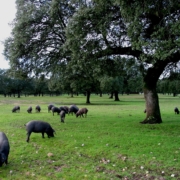Saffron the Most Expensive Spice in the World
Saffron is the most precious and expensive spice in the world and is often said to be worth its weight in gold. The Saffron filaments, or threads, are actually the dried stigmas of the saffron flower, “Crocus Sativus Linneaus”. Each flower contains only three stigmas and these threads must be picked from each flower by hand; more than 75,000 of these flowers are needed to produce just one pound of Saffron filaments, making it
the world’s most precious spice. However, because of saffron’s strong coloring power and intense flavor, it can and should be used very sparingly.
The arrival of autumn means only one thing for many of the inhabitants of Castilla-La-Mancha in Spain – time to harvest its ever precious saffron. From October 29 to 31 the historic town of Consuegra is holding its annual Saffron Rose Festival, which, organized to coincide with the harvest, celebrates all things Manchego.
Visitors can enjoy the competition in which nimble-fingered locals separate the saffron spice from the flower or take a trip to the Molienda de Paz to watch wheat flour being made at the old Sancho windmill. The star of the show is of course the purple saffron flower and with the searing summer heat having passed, villagers will flock to nearby fields and begin the arduous task of plucking purple crocus heads. But with the price to the farmer standing at 1200 euro a kilo, and it selling for just over a euro a gram in the market place, it is worth the 40 hours of manual labor that it takes to produce a kilo of the prized spice.
So delicate are the stigmas that the production of saffron is now one of the few food processes that is still completely non-mechanised and the whole chain from harvesting and drying, right up to packaging, is totally done by hand for fear of damaging the delicate stigmas. Nevertheless, time is still of the essence as – for every hour that passes – the intensity of the color and the flavor diminishes as well as the value of the spice.
Whole villages therefore fight the back-breaking conditions to collect as much saffron as possible during the three week harvest period. Thanks to specialist knowledge handed down over generations, the Castilla-La-Mancha harvesters are highly adept at ensuring their export loses minimal value during the production journey.
Spain is actually now the second largest saffron producer in the world, after Iran. Spanish food lovers argue that their azafran (saffron from the plains of Castilla-La-Mancha) is unrivalled across the world. They have even nicknamed it ‘oro’, gold. The most famous dish containing saffron is of course paella, but many other dishes including fish stews, soups and meat stews, known as fabada’s, made from white beans, pork, and spicy sausage also have their own dashes of saffron.
If you would like to experience this unique festival with us at Gourmand Breaks, our private Food and Wine Tours can be customized to include this along with many other authentic local Spanish experiences.



